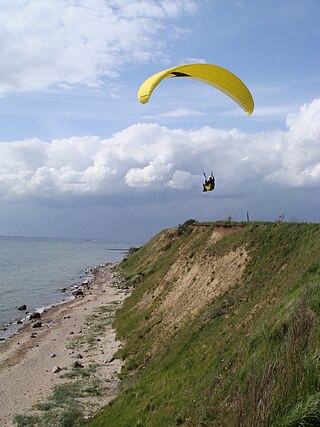Related Research Articles
The Advance Epsilon is a family of Swiss single-place paragliders designed and produced by Advance Thun of Thun.

The Advance Omega is a series of Swiss single-place, paragliders, designed and produced by Advance Thun of Thun.

The Gradient Aspen is a Czech single-place, paraglider designed and produced by Gradient sro of Prague. Introduced in 2003, it remained in production in 2016 as the Aspen 5.
The Gradient Bright is a Czech single-place, paraglider designed and produced by Gradient sro of Prague. Originally produced in the mid-2000s, it was still in production in 2016 as the Bright 5.
The Gradient Golden is a Czech single-place, paraglider designed and produced by Gradient sro of Prague. Originally produced in the mid-2000s, it was still in production in 2016 as the Golden 4.
The Mac Eden is a Czech single-place paraglider that was designed by Peter Recek and is produced by Mac Para Technology of Rožnov pod Radhoštěm. It remains in production in 2016 as the Eden 6.
The Mac Muse is a Czech single-place paraglider that was designed by Peter Recek and produced by Mac Para Technology of Rožnov pod Radhoštěm. It remained in production in 2016 as the Muse 4.
The Mac Pasha is a Czech two-place paraglider that was designed by Peter Recek and is produced by Mac Para Technology of Rožnov pod Radhoštěm. It remained in production in 2016 as the Pasha 5.
The Sky Atis is a Czech single-place paraglider, designed and produced by Sky Paragliders of Frýdlant nad Ostravicí. It was introduced in 2003 and remained in production in 2016 as the Atis 4.
The Sol Kangaroo is a Brazilian two-place paraglider that was designed and produced by Sol Paragliders of Jaraguá do Sul starting in the mid-2000s. It remained in production as the Kangaroo 4 in 2016.
The Sol Prymus is a Brazilian single-place paraglider that was designed and produced by Sol Paragliders of Jaraguá do Sul starting in the mid-2000s. It remained in production as the Prymus 4 in 2016.

The Swing Arcus is a series of German single-place and two-place paragliders, designed and produced by Swing Flugsportgeräte of Landsberied. In 2016 it remained in production as the Arcus 7.
The Astral is a German single-place paraglider that was designed and produced by Swing Flugsportgeräte of Landsberied. It is now out of production.
The Mistral is German single-place paraglider that was designed and produced by Swing Flugsportgeräte of Landsberied. It is now out of production.
The Stratus is a German single-place paraglider that was designed and produced by Swing Flugsportgeräte of Landsberied. It is now out of production.
The U-Turn Infinity is a German single-place paraglider, designed and produced by U-Turn GmbH of Villingen-Schwenningen. It was the first glider introduced by the company in 2003 and remained in production in 2016 as the Infinity 4.
The UP Kantega is a family of German single and two-place paragliders that was designed and produced by UP Europe of Kochel am See. Introduced in 2003, production of the final version ended in 2016.
The UP Makalu is a German single-place paraglider that was designed and produced by UP Europe of Kochel am See. Introduced in 2001, production of the final version ended in 2020.
The UP Summit is a German single-place paraglider, designed and produced by UP Europe of Kochel am See, now UP International of Garmisch-Partenkirchen. Introduced in 2001, production continued through 2016 with the Summit XC4 model.
The UP Trango is a German single-place paraglider, designed and produced by UP Europe of Kochel am See, now UP International of Garmisch-Partenkirchen. Introduced in 2002, production continued through 2016 with the Trango XC3 model.
References
- 1 2 3 4 5 6 7 8 Bertrand, Noel; Rene Coulon; et al: World Directory of Leisure Aviation 2003-04, page 10. Pagefast Ltd, Lancaster OK, 2003. ISSN 1368-485X
- 1 2 3 4 Advance Thun SA. "Sigma 6 Technical details". advance.ch. Archived from the original on 2 December 2007. Retrieved 14 March 2016.
- 1 2 3 4 Advance Thun SA. "Signma 7: Technical details". advance.ch. Archived from the original on 16 February 2010. Retrieved 14 March 2016.
- 1 2 3 4 Advance Thun SA. "Sigma 8: Technical details". advance.ch. Archived from the original on 25 March 2013. Retrieved 14 March 2016.
- 1 2 3 4 Advance Thun SA. "Sigma 9". advance.ch. Archived from the original on 12 March 2016. Retrieved 14 March 2016.